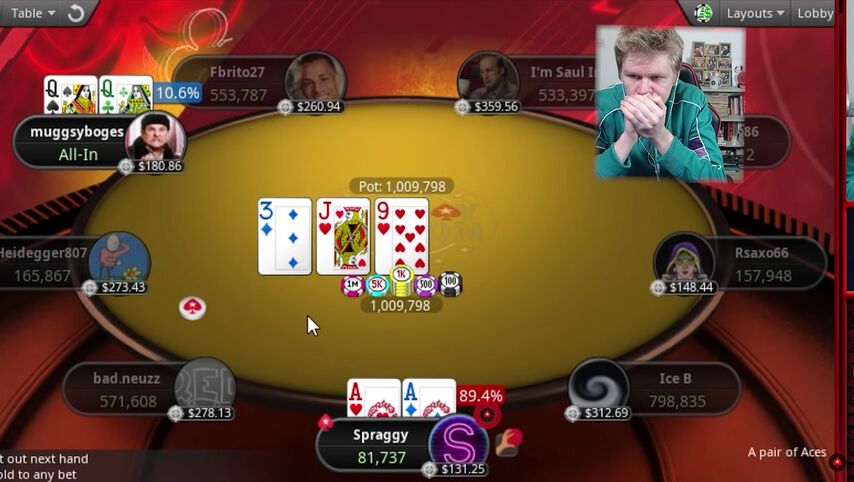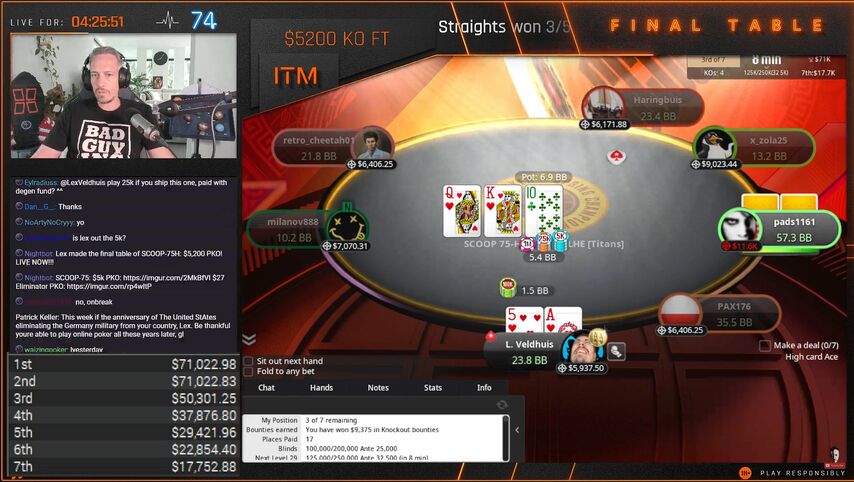Probability is the degree of certainty we can expect, and that’s immensely useful in poker. Understanding poker probability is one of the first steps to becoming a better player. Knowing the odds has always been an important part of poker, but it’s becoming more valuable these days. Armed with probability, you’ll make more accurate decisions against your opponents.
In this article, all of the calculations and math are done for you. We’ll talk about some common Texas Hold ‘em probabilities for common situations every poker player faces, like:
- Drawing for a flush, straight, and other combinations
- Making a pair or better on the flop
- Being dealt pocket pairs and other hands preflop
We’ll start with the basics first.

Poker Probability Basics
While you’re playing, it can be tough to think about probability, especially when you don’t have much time. Modern poker sites, like GGPoker, display probabilities as a percentage for all-in situations, but nothing else during the action in a hand.
There are 52 cards in a deck used for Texas Hold ‘em and other kinds of poker.
Let's say you are dealt A♥ K♠ during a hand of Texas Hold ‘em poker. What is the probability that you will make a pair of Aces or Kings on the flop?
You’ll make a pair almost one-third of the time; a probability of 29%, to be exact.
Here’s How to Calculate Probability in Poker:
In Texas Hold ‘em poker, you’ll be dealt 2 cards and the other 50 will be unknown to you.
50 is a good number for us to work with and generate probabilities from. The chances of seeing a specific card on the flop are 1/50 (also expressed as 2/100), which is equal to 2%.
If you don’t have much time, you can estimate that any card can appear on the flop, turn, and river with a roughly 2% probability.
So if you need one of the nine hearts in the deck to come on the turn, you can multiply 2% by 9 cards to find the rough probability of 18%
You’ll notice that almost all online poker sites show you your hand's probability once you go all-in. For example, take a look at this hand on PokerStars, where both players are all in. Spraggy has an almost 90% probability of winning the hand and is one step closer to winning the Sunday Million. You can use a poker odds calculator to find out probabilities like this for specific situations.

Even though he didn’t win the Sunday Million, Spraggy still took home almost $5,000 in winnings from a 17th-place finish. The site has many other tournaments, some with massive prize pools for small entry fees. One example is the Hot $4.40 with a $3,000 prize pool or the larger Hot $11 with a $10,000 guaranteed prize pool.
If you want to get started, this site is offering a few welcome bonuses for new players. If you want to maximize your bankroll and join a growing player base on a trusted platform, read our full review of PokerStars.


Probability For Drawing in Poker [What are “Outs”?]
Outs are a poker term for the cards you need to make your hand combination. For example, if you’re drawing to make a flush, there are 9 cards that will complete your combination. There are 13 cards in each suit, minus the two in your hand and minus the two on the board (13 – 4 = 9).

Team Pro for PokerStars, Lex Veldhuis, has an incredible flop in front of him. With a flush draw he has 9 outs, but he also has an inside straight draw that completes if a Jack hits the board. In total, he has 13 outs; all of them will make him the best possible hand combination.
Sometimes you’ll have outs for two different hand combinations and you’ll need to look at their probability separately. For example, a hand like A♥ K♥ with a flop showing J♥ 10♥ 4♣ has three different draws; one for a straight, flush, and straight flush.
If you have an open-ended straight draw, then what are the chances that you hit your card to complete it? An open-ended straight draw consists of four consecutive cards, such as 6-7-8-9. Our outs in this situation, are any 5 or 10, which will complete our 5-card straight. There are 8 cards that complete our straight (four 5s and four 10s), which gives us a probability of 17%.
Calculate the probability of hitting your outs by using the following equation:
(Cards you need to make your hand) divided by (the total number of cards remaining)
Remember to exclude the cards on the board and the cards in your hand when calculating.
Here are some common probabilities for drawing in poker:
| Hand | Outs | Chance of hitting on the turn | Chance of hitting on the river |
|---|---|---|---|
| Pair | 6 | 12.8% | 13% |
| Set | 2 | 4.3% | 4.3% |
Straight (open-ended) | 8 | 17% | 17.4% |
Straight (gutshot draw) | 4 | 8.5% | 8.7% |
| Flush | 9 | 19.1% | 19.6% |
Straight Flush (open-ended) | 2 | 4.3% | 4.4% |
Straight Flush (gutshot draw) | 1 | 2.1% | 2.2% |
Practice counting your outs in a freeroll tournament and you’ll have a chance at winning real cash without investing a cent of your own money. Some free poker tournaments have prize pools starting at $50 or $100, but there are also satellite freerolls which give winners tickets to bigger real money events. Browse through our full selection or take a look at some of our favourite freerolls.
- Increased first deposit bonus
- Increased rakeback and reloads
- Help with deposits and cashouts
- Access to private freerolls
- Round-the-clock support
Odds of Being Dealt a Specific Hand [Like Pocket Aces]
Sometimes you’ll “run hot” and get dealt lots of premium hands; other times you’ll feel “card dead” and not see strong cards very often. Here are the odds of being dealt specific hole cards, like pocket pairs.
Probability of being dealt:
- Specifically Ace King of the same suit: 0.003%
- Specifically pocket Aces: 0.004%
- Any pocket pair (Q♥ Q♣, 9♦ 9♣, 6♦ 6♠, and so on): 0.058%
- Suited connectors (7♥ 8♥, J♣ Q♣, 9♦ 10♦, and so on): 0.03%
- Unsuited connectors (7♥ 8♣, J♦ Q♣, 9♦ 10♠, and so on): 0.157%
Here’s what you can expect when you move from preflop to flop and see three community cards.
Probabilities For Flopping Hands in Poker:
| Hand Combination | Probability of Making Combination of the Flop |
|---|---|
| One Pair | 29% |
| Two-Pair | 2% |
| Three-of-a-Kind | 1.35% |
| Set | 11.8% |
| Straight | 1.3% (with cards like 6-10 or J-Q that can both be used) |
| Flush | 0.8% |
| Full House | 0.98% |
| Straight Flush | 0.02% |
| Royal Flush | 0.005% |




















